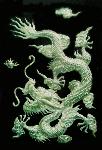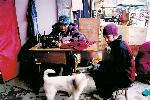- Getting around Lijiang. Dont stay in the Old Towns more than 2 days, there is nothing to do. KRISS Oct 9, 2013 05:46
- 2013 Beijing Temple Fair BENNYLAU Feb 26, 2013 03:29
- Malaysian traveling from KUL - LAX vis Shanghai PVG ZATI_DY Jan 3, 2013 20:15
The Green Hills of Yangshuo -- Part 2
- Views: 5412
- |Vote: 1 1
- |Add to Favorites
- |Recommend to Friends
Xijie -- A Shopping Paradise
In almost no time, we found accommodations: a two-bedroom and living-room suite for only 180RMB a night near the river. It was a steal, considering we had a third-floor view of the Li River and were almost next to a karst hill. Every morning and evening, when I opened the balcony door, the smell of wood smoke would drift in from the valley, and make me feel right at home.
Xijie is a nice place to shop for souvenirs and spend the evenings since the restaurants serve international foods, and the sidewalk patios are mellow places to socialize in pleasant company. In my time there, I noticed many French tourists pass through and that there are indeed several French restauranteurs who live in Yangshuo. The first morning, we had breakfast at a French bistro and were amazed to find fruit crepes, muesli, and real hot chocolate on the menu. In the two years I’d lived in Korea, I hadn’t seen these items on any menu, and was thrilled that the owner knew how to make a real cup of hot chocolate with cream and chocolate -- it was possibly one of the best cups of hot chocolate I've ever had.
The owner of this bistro was from France and had given up his life here to open a bistro here. Another Frenchman down the street, named Jean, plays the fiddle at his sidewalk bar in the evenings and seems very happy with his life in Yangshuo. Another block down Xijie, there's a French restaurant named Le Votre that is less well-known, but is housed in the impressive heritage home of a past nobleman. It is set back a ways back from the road, and looks like a classy establishment, but it was said to us by another tourist that the food there wasn't quite up to Parisian standards.
Clothing of the Ethnic Minorities
The other nice thing about West Street, is that its tourist industry helps the local economy and betters the lifestyle of many farmers living the area, who otherwise make little coin off their crops. By browsing through the stores, you can get a very good idea of the handicrafts, and dress of the local ethnic minorities without even going to their remote villages. The ethnic clothing here exhibits the skillful embroidery work that girls spend years practicing from childhood so they can be good marriage partners. Their people lead an agrarian way of life, so it is important for women to be skilled in the arts of homemaking and for men to be good farmers. Their courtship rituals also include singing, because they’ve been singing all their lives while working in the fields.
The Zhuang, by far the largest minority in this area, are more puritan in their fashion sense – and commonly wear blue or black clothing, with elegant rows of black or steel buttons. This looks particularly handsome on men; I thought it might have been the Chinese equivalent to an Armani suit. The Miao girls own collections of massive silver headresses, huge necklaces, and other body ornaments that show their personal wealth -- and they typically display them at village festivals, such as singing festivals or village meals. As for their children, they wear embroidered hats ornamented with silver thimbles (with scary faces) that ward away evil spirits. These unique garments would make meaningful souvenirs to bring home. As for the antique stores I saw in the area, they seem to be garage sales of the minority villages used liquidate their old items.
Artwork made by Local Artisans
Like many women, I like shiny things – and was drawn to the silver jewelry and decorations made by a Bai minority family from Yunnan, sold in a shop next door to my hotel. They made bracelets, earrings, relief artwork, and silverware sets suitable to be given as wedding gifts. The quality of their handiwork was truly exceptional. Having worked alongside his uncle for the past seven years, the young silversmith was just finishing his apprenticeship. After speaking with them awhile, and staying for dinner, I noticed that it was not easy for them to make a living. Their family of three slept in cots at the back of the unheated store behind a small curtain, that separated them from an equally small cooking area, and they made a small profit only after paying a very high amount of rent. To them, coming to Yangshuo had been an experiment and they weren't sure yet if it was paying off, financially.
Yanghsuo seems to have a large number of artists, either in her streets, or hiding and painting in her countrysides. I think most of the calligraphy Xijie’s shops is written for tourists, and although they look trite to me, they could make nice gifts for non-Mandarin speakers. If you are buying from a collecter's perspective, you should go into the back or upstairs galleries of the stores. That’s where they keep the nicer paintings for people who are seeking to augment their home galleries. It is common now for Chinese artists to combine Asian and Western techniques in scroll paintings – the brilliance of acrylic and oil colours with the simplicity of traditional ink. If you buy landscape scrolls, it's better to purchase the same landscape in different seasonal depictions – and display them together in a room.
The Chinese Side of Yangshuo
I did manage to explore the Chinese side of town too -- it looks dustier and less well kept than the Western side but has a salt-of-the-earth character that is more truly reflective of local residents' lives. After searching all over town, I was pleased to find a calligraphy store where I stocked up on brushes, inks, papers, and exercise books, since they’re all cheaper here than they are in Xijie. The cobblers, the tailors, the bookstore, fruit vendors – I visited all of them --- and at the grocery store I bought some West Lake lotus root starch, from which the locals make a mucus-like dessert that they top with pine nuts, peanut powder, osmanthus flowers, and wolfberries. It has an unusual texture, but is quite delicious.







 Copyright © 1998-2025 All rights reserved.
Copyright © 1998-2025 All rights reserved.